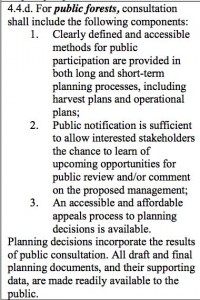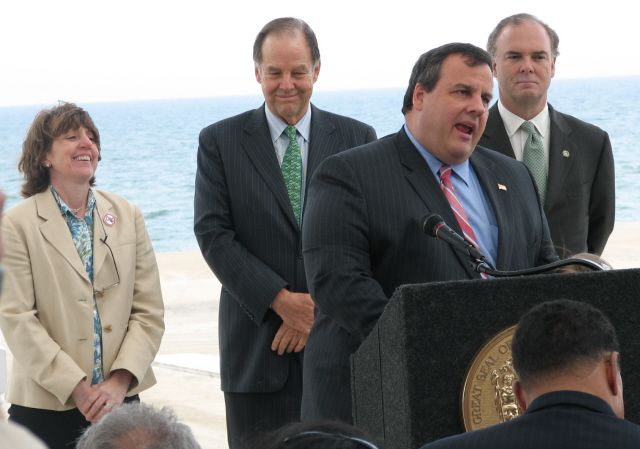“Forest Stewardship ” Bill Lacks Adequate Safeguards and Public Oversight
A Matter of Aspirational Goals and Rhetoric Vesus Regulatory Standards
In this post, I hope to explain, in some detail, why the “Forest Stewardship” bill lacks adequate safeguards and public oversight.
In order to do so, it is very important that people keep in mind a basic distinction between a regulatory protection and a rhetorical protection – and focus on exactly what a regulatory protection provides, compared with a rhetorical protection.
It would also help if readers actually read the bill (please feel free to pose questions and comments on the text – I will gladly respond. I also invite and challenge bill supporters to defend their claims.)
[and take your own look at FSC , who they are, and what they’re about – looks like the objectives and personnel are as much about marketing and market development for forest products, as ecosystem integrity – keeping in mind that FSC, by design, is voluntary]
The press seems incapable of making that basic distinction, as do the bill’s supporters. *(see this Press of Atlantic City editorial as a good example – Logging in State Forests/Reasonable Approach)
The bill does NOT provide regulatory protections for state owned forests that govern damaging forestry activities, like road building, equipment storage, or logging practices – Period – even when these damaging activities destroy wetlands, C1 stream buffers, erosive soils or steep slopes, and water quality.
Existing environmental laws provide huge loopholes for forestry – here is DEP’s own explanation to illustrate the point:
- Stream Crossings
Stream crossings represent the point at which a forest road or skid trail comes in contact with a body of water. The purpose of a stream crossing is to provide a stable bottom or surface that allows for equipment to cross intermittent or perennial streams without increasing stream sedimentation.
In the case of temporary crossings, the DEP may issue a letter of no jurisdiction rather than a permit.
- Regulations and Procedures for Wetlands and Buffers
In order to protect the integrity of our water resources, the Freshwater Wetlands Protection Act (FWPA) regulates many activities including forestry conducted within forested wetlands and transitional areas. Specific forestry activities have been granted a conditional exemption of the requirement of needing a wetlands permit.
The bill perpetuates and expands these loopholes, and in some ways makes them worse.
For example, current laws and regulations allow the DEP forester to exercise discretion on how to protect regulated natural features, like wetlands and stream buffers. The Forester can relax regulatory requirements to provide “flexibility”.
The DEP Commissioner can tell the state Forester what to do, and she can be influenced by political or economic considerations that trump science and sound policy. That happens now.
But the bill would make the current situation worse in important ways. First, by providing an incentive to DEP to bend the rules to promote commercial logging because DEP is the recipient of the revenue from timber sales. This is what economists call a perverse incentive. There is a built in incentive to promote logging. I likened it to funding Alcoholic’s Anonymous with liquor taxes.
Second, the bill explicitly provides that it is the “state forester” who makes the discretionary and unchallengeable decisions about how to implement the program.
Third, this is all given the veneer of scientific legitimacy by 3rd party certification by the private FSC, who will have far more influence over a forest plan in your backyard than you will. FSC will certify what you will be shut out of, and you will have to live with the consequences. That is a form of privatization, not public governance.
The State Forester is provided total discretion, not subject to any regulatory standard (with the exception of Pinelands forests) or public review process. This is wrong – it provides vague discretionary power that is prone to abuse, given the economic values of timber harvests and the conflicts of interest created by perverse incentives to fund DEP programs.
In terms of providing standardless discretion to DEP (as in meaningful standards, not rhetoric like “sustainable” and “forest health” and “net environmental benefits” and other vague provisions in the bill), the bill is no different legally than the controversial DEP waiver rule (pending Supreme Court challenge by environmental groups).
Actually, the waiver rule has far more safeguards than the so called “standards” in the bill, because at least the waiver rule was justified and openly proposed for public comment as a rule, and was able to be challenged in court, all of which the forestry program created under bill does not have to do and can not be so challenged. So, any environmental supporters of the bill are hypocritically endorsing the same standard that they are challenging before the Supreme Court.)
On top of these flaws, there are no procedural protections to allow public oversight.
There are no requirements in the bill that the DEP Forester provide an opportunity for the public to review and comment on the “active forests stewardship program” DEP is required to develop under Section 3, including priority criteria by which to target individual forests for logging, the procedures for public and DEP review, and the design and application of the various environmental “standards” that are described as “safeguards”, including those of the Forestry Stewardship Council (FSC), who is given a quasi regulatory role in the program.
DEP must provide ample opportunities for public comment in virtually all major environmental planning programs, including the State Implementation Plan under the Clean Air Act, the Water Quality Plan under the Clean Water Act, the Coastal Policy and Plan under CAFRA, the Solid Waste Management Plan, and the Water Supply Master Plan.
In addition to public involvement and oversight, those plans are all backed by regulatory protections.
Our forests deserve no less.
DEP planning for managing our State forests should be given the same public participation process and be backed by regulatory protections, as all other major environmental planning and management programs. PERIOD. But they are not.
In contrast to enforceable, transparent, and publicly accountable regulatory protections, the Forest Stewardship” bill is loaded with rhetorical protections.
But, with the exception of forests in the federally protected Pinelands, the bill’s rhetorical protections are ephemeral, aspirational, and legally not enforceable. In other words, virtually meaningless and subject ONLY to the whim of the State Forester in DEP – with no review or recourse to challenge by the public.
But, there is one important exception that proves my point: the bill does give Pinelands forests regulatory protections and any forestry activities must comply with the Pinelands Act and the Comprehensive Management Plan, and are subject to the review and approval by the Pinelands Commission, following a public process.
However, logging equally ecologically sensitive and far more significant and economically valuable Highlands hardwood forests are not given those same protections.
You don’t have to be a lawyer to understand that – here is the language of the bill itself. Compare the Pinelands language to the Highlands language in Section 4:
Pinelands forests:
6) ensure that in the pinelands area as defined in section 10 of P..1979, c.111 (C.13:18A-11), all activities conducted pursuant to a forest stewardship plan on State-owned lands comply with all provisions of the “Pinelands Protection Act,” P.L.1979, c.111 (C.13:18A-1 et seq.) and the comprehensive management plan adopted pursuant thereto.
Highlands forests:
(5) ensure that the implementation of forest stewardship plans on State-owned lands located in the Highlands Region is consistent with the provisions of the “Highlands Water Protection and Planning Act,” P.L.2004, c.120 (C.13:20-1 et al.);
There is no mandate that logging comply with the Highlands Act, the Highlands Regional Master Plan, or the standards in the DEP Highlands regulations (the term “consistent with” is not legally the same as “comply with”). There also is no requirement in the bill for review and approval by the Highlands Council (and thus no public oversight provided by Highlands Council review either).
The bill would compound a loophole in the Highlands Act with respect to forestry activity on privately owned lands. That loophole would be perpetuated and expanded by the bill to include public lands, when the bill should be closing that kind of loophole and mandating the highest standards for publicly owned forested lands.
On top of that, the bill lacks any mandates for public involvement in DEP’s development of the “Stewardship” program, including developing priorities and criteria for defining forest management objectives and drafting individual forest management plans.
Let me explain and back these claims up.
Regulatory protections are binding and they are enforceable. Regulatory protections provide the public an opportunity to participate in the development of the regulations themselves, via what is called “public notice and comment rule making” under the NJ Adminsitrative Procedure Act.
Rulemaking provides what lawyers call “due process”. The public proposal and adoption of rules is an important safeguard to assure that the public is involved in the design of the forestry program and also assures that the program is based on transparent standards and science, not economic or political factors.
The bill does NOT require DEP to promulgate rules to adopt the forest management safeguards.
The bill does NOT require that the Forest Stewardship Council’s standards, which DEP prepared Forest Management Plans must meet, be adopted as rules.
Last year, as part of the pro-business “Red Tape Commission recommendations, the legislature passed a bill, signed into law by the Governor, that prohibits DEP from enforcing “Guidance documents”, see P.L. 2012, c.215.
“Guidance docuemtents” are technical requirements that have not been formally adopted as regulations through public rule making procedures.
ALL the so called standards and safeguards in the forest stewardship bill – including all of the specific standards in section 3 and the Forest Stewardship Council’s standards too – are legally the equivalent of guidance because they are not adopted procedurally as rules.
That means that they are all unenforceable and that the public will ave no rle in their development.
It also means that Forest Management Plans are not required to received DEP permits – the permit process also provides transparency, public review, and legally binding requirements.
For example, temporary forest access roads and even bridges through wetlands and across sensitive Category One streams and their protected 300 foot buffers do not require permits.
Other examples of rhetorical standards and political manipulation abound.
For example, Section 3.e of the bill appears to prohibit logging in designated “Natural Areas” (a bone thrown to environmental critics). But, the DEP forester can waive this so called ban with a finding of “net environmental benefits”. There is no public process to control or standards that define and govern what “net benefits” are, and that entire “net benefits” concept is vague and prone to abuse, as it was used in the controversial DEP waiver rule.
Another example is that the bill appears to provide funding to the Hunters and Angelrs Fund and for “biodiverstiy” projects. Sounds good, right?
But those funds are NET revenues – money remaining from timber sales AFTER DEP’s forestry program is funded.
This raises two issues: first, if there are net proceeds, that suggests a large scale logging operation. Bad.
Second if this is a small scale logging program, as the bill’s backers insist, then there will be no “net revenues” and those provisions are exposed as a sham to induce political support from hunters, anglers, and conservationists. Bad.
Like so much of this rhetorical bill, that exposed as a lose/lost proposition.



